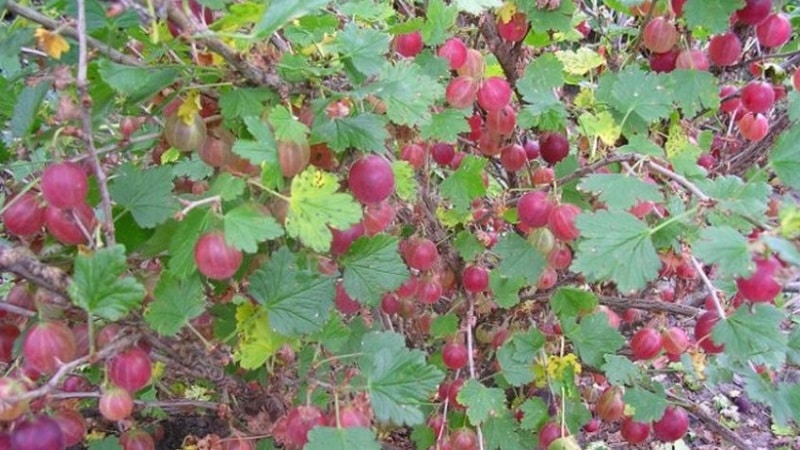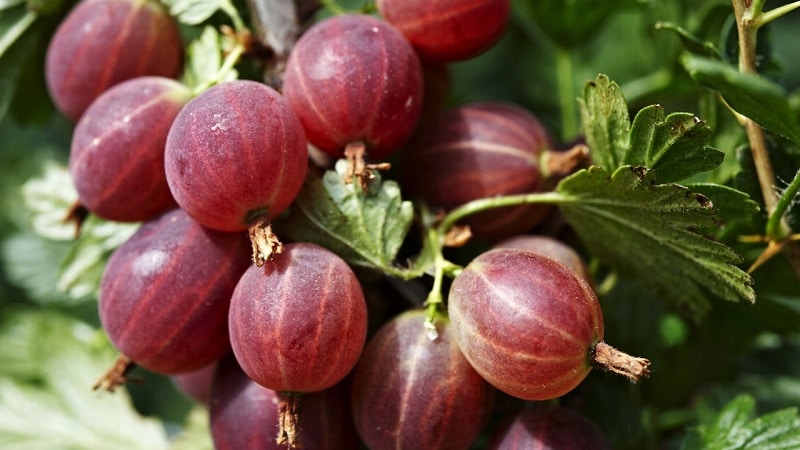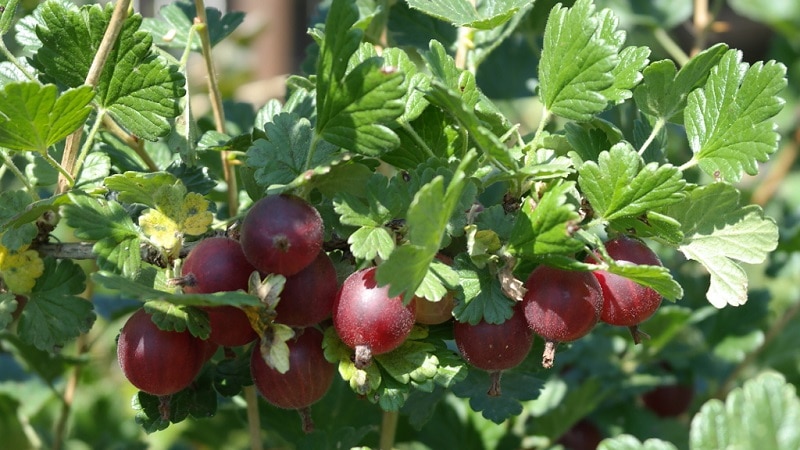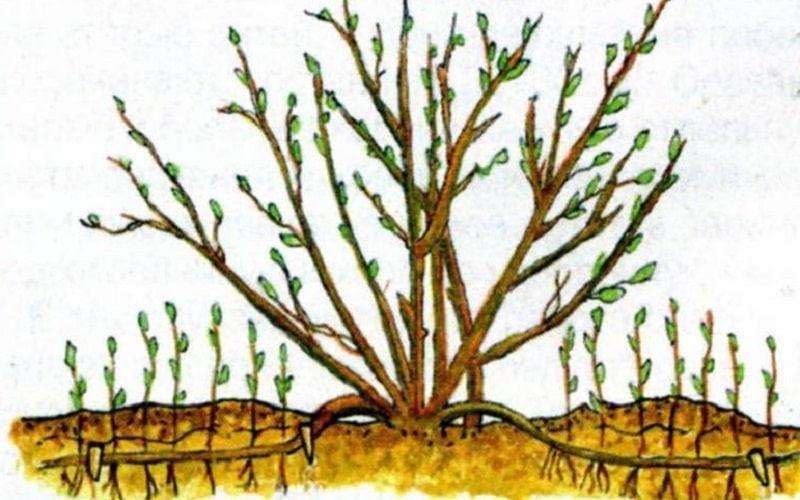Young, increasingly popular gooseberry variety Krasnoslavyansky from Russian breeders
Krasnoslavyansky gooseberry is a relatively young variety, but very promising due to its characteristics: high productivity, excellent taste, and the visual attractiveness of the berries. However, this is not the entire list of advantages of the shrub. For a detailed description of the variety, whose popularity is growing every year, read the article.
Gooseberry variety Krasnoslavyansky
Despite the fact that many new varieties of gooseberries have appeared in recent years, Krasnoslavyansky is still considered by many to be one of the sweetest and best dessert varieties.
The culture is characterized by average ripening period: in late May - early June it begins to bloom, and in late July - early August it bears fruit. In one place it can grow and bear fruit for up to 14 years.
History of origin and distribution
Krasnoslavyansky gooseberry is the result of the work of Russian breeders. It was created at the Leningrad fruit and vegetable experimental station, after which it was tested for 10 years. In 1992, Krasnoslavyansky took a place in the State Register of Selection Achievements.
To obtain a new crop, the popular varieties Avenarius were crossed, from which Krasnoslavyansky inherited exceptional taste and high winter hardiness, as well as Oregon, known to gardeners for its unpretentiousness.
Krasnoslavyansky gooseberry: characteristics and description of bushes
The gooseberry bush is decorative and can decorate any dacha or garden plot. The plant is compact, with a slightly spreading crown. The height is about 1.5 m. Strong branches and shoots are directed towards the sun at an acute angle.
Their colors are not the same: the bottom is light brown, the rest of the shoot is green. There are medium-length sharp thorns, which causes inconvenience when caring for the plant and harvest.

The leaves are bright green, shiny, openwork, medium-sized. The flowers are yellowish, small, and bell-shaped. Full crops are harvested from bushes over 6 years old. One plant produces up to 6-8 kg of high quality berries. You should not delay harvesting, otherwise the fruits may fall off the bush.
Temperature resistance
The variety feels good both in southern and more temperate latitudes. It is characterized by high winter hardiness and can easily tolerate temperature changes and harsh winters (up to -35°C). It is enough for him to be under snow cover in order not to suffer from frost and strong winds.
Moisture and drought resistance
It is undesirable to plant the shrub in lowlands, where after rains and melting snow a lot of moisture and cold air accumulate, which will negatively affect the flowering of the crop. Gooseberries also do not like wetlands. In such conditions, the plant develops poorly, is often affected by fungal diseases and produces a meager harvest. The groundwater level should be no closer than 1-2 m to the ground surface.
Krasnoslavyansky gooseberry is a drought-resistant crop. However, in hot summers and a long absence of rain, it requires moderate watering.
Resistance to diseases and pests
The variety is characterized by strong immunity to many diseases and pests.However, due to improper care and high humidity, gooseberries are sometimes affected by powdery mildew, anthracnose and white spot.
Characteristics and description of the fruit
The berries look very attractive. They are large, weighing 6-7 g. The shape is round, maybe oval. At the ripe stage, the fruits acquire a dark red color with a cherry tint. The taste is sweet with a slightly noticeable sourness, aromatic, with tender and juicy pulp. Tasting score – 4.9 out of 5 points. The skin is thin but durable with slight pubescence.
Areas of use
The berries are used for fresh consumption, as well as for making preserves, jams and compotes. Sweet fruits are used to make excellent sauces for fish and meat dishes, as well as fillings for baked goods.
The berries of the Krasnoslavyansk gooseberry are also dried. In this form they are very reminiscent of raisins.

Advantages and disadvantages of the variety
The main advantages of this gooseberry:
- good immunity;
- high productivity;
- precocity;
- ease of care;
- high taste qualities;
- good transportability without loss of presentation.
Flaws:
- the abundance of thorns on the shoots complicates care and harvesting;
- overripe fruits fall off very quickly;
- average susceptibility to fungal diseases.
Growing technology
The growing technology is simple, but it is important to take into account certain nuances and create optimal conditions for obtaining a good harvest.
Optimal conditions
Conditions for growing Krasnoslavyansk gooseberries should be as follows:
- Almost any soil is suitable for the culture. But the largest harvests are obtained only on well-fertilized and fertile soil. Only highly podzolized and acidified soils are not suitable for cultivation.
- It is advisable to choose a well-lit place.Areas with partial shade are also suitable, but in the shade the shrub will not develop well. In shaded areas, the shoots begin to stretch upward and become thin, and the berries become crushed.
- The site must be without drafts. It is advisable to plant bushes near a fence or walls of a building.
- The minimum level of groundwater is 1.5 m. If there is excessive humidity, the shoots will freeze. Also, with a high level of groundwater, there is a possibility of rotting of the root system.

Landing dates and rules
Planting is carried out in spring or autumn time. In the spring this is done after the snow melts and before the buds open, and in the fall - a month before the first frost. Seedlings must be annual or biennial.
First, prepare the landing hole. Its depth should be about 60 cm, and its diameter should be 50 cm. The distance between seedlings in a row is maintained at 1-1.5 m, and the distance between rows should be at least 2 m.
At the bottom of the planting hole, a drainage layer of stones 15 cm thick is made. After this, the hole is filled halfway with a nutrient substrate, which consists of:
- 2 buckets of humus;
- 2 buckets of topsoil;
- 1 bucket of peat;
- 250 g of ash;
- 200 g superphosphate.
Then 3 buckets of water are poured into the hole.
Before planting, the roots of the seedlings are soaked in water for 1 hour, after which they are treated with any store-bought root formation stimulator (according to the instructions) or a mash made of clay and mullein.
The seedling is placed in a planting hole, the roots are straightened and covered with soil. The soil is compacted a little to remove air pockets. After planting, the root collar should be 5 cm below the ground surface.
Then the tree trunk circle is mulched with straw, sawdust or humus. The planted bush is pruned so that there are 4-5 buds on each shoot.
Further care
Subsequent care consists of creating support, regular feeding and pruning.
This variety has branches that grow upward and to the sides, so when there is a bountiful harvest, they bend to the ground. To preserve berries they do it around the bushes supports. To do this, hammer in several stakes and stretch a wire between them.

Red Slavic gooseberry requires high-quality feeding. It is carried out 3 times:
- In early spring, nitrogen-containing fertilizers are scattered on the snow. When the snow melts, they will fall into the soil. At the same time, 10 kg of rotted manure, 20 g of saltpeter, 80 g of superphosphate and 20 g of potassium chloride are added to each bush.
- During the flowering period, the crop is fed with potassium-phosphorus fertilizers. If growth is weak, additional nitrogen is added.
- In autumn, plants also require potassium-phosphorus fertilizers. This will allow the bushes to overwinter normally.
Pruning is carried out in autumn according to this scheme:
- 1st year. The branches are cut by a third, leaving 4-5 buds. Cut out all the branches except the 3-4 strongest ones that grow upward.
- 2nd year. The shoots are pruned in the same way as in the first year. But now they leave 6-8 basal branches on the bush.
- 3rd year. Pruning is carried out in the same way. Leave 10-17 branches.
- 5-7th year. There are already up to 20 shoots in the bush. Cut out all branches that are older than 5 years. The remaining ones are cut by a third.
Possible problems, diseases, pests
Culture is amazing white spot, anthracnose, spheroteca. To avoid these diseases, bushes are treated.
Before the buds swell, the branches are sprayed with the drug “Nitrophen” (diluted with 300 g of the substance per bucket of water) and a solution of copper sulfate (30 g per 10 liters of water).2 weeks after harvesting, the gooseberries are additionally sprayed with Bordeaux mixture. To do this, 100 g of the substance is diluted in 10 liters of water.
Dangerous pests include moths, moths and aphids. To prevent their appearance and destruction, gooseberries are treated with Actellik, Metafos or Karbofos.
Wintering
In autumn, moisture recharging is performed watering. First, the soil is loosened to a depth of 10 cm, after which 5-6 buckets of water are poured under each bush. The tree trunk circle is mulched with peat or sawdust.
If the winters in the growing region are snowy, gooseberries are not covered. When there is little snow, agrofibre is used for protection.
Reproduction
Usually Krasnoslavyansk the variety is propagated by using:
- Layers. In the spring, trenches are made near the bushes, into which young and long shoots are laid. They are covered with earth, watered and pinched. It is important that the soil is always moist and loose. By autumn the shoots give rise to roots. They are separated from the mother bush and transplanted to a permanent place.
- Divisions. For this method, the bush must be young, no older than 5 years. The plant is dug up and divided into several parts, which are then planted.

Features of cultivation depending on the region
The new variety received permission for cultivation in the North-Western, Central and Volga-Vyatka regions, but over time the geography of its cultivation has expanded significantly. It has successfully adapted to the climate of most regions of Russia. Gooseberries are planted in cold areas because they tolerate severe frosts well. In the northern regions, bushes require shelter. In the fall, spruce branches are used, and with the arrival of winter, additional snow is raked.
Pollinator varieties
The Krasnoslavyansk variety is self-fertile and does not require additional pollinating plants. Young bushes produce their first harvest in 2-3 years.
Reviews from summer residents
Gardeners note the ease of cultivation, high taste and productivity.
Ekaterina, Transbaikal region: “My husband and I planted this gooseberry 3 years ago. No other varieties were grown previously. There were no particular difficulties. Last year we got our first small harvest, from which I made jam. It turned out very tasty and aromatic".
Ivan, Ekaterinburg: “The Krasnoslavyansk gooseberry appeared at the dacha thanks to my mother, she only grew this variety. I decided to continue the tradition. I propagate shrubs using layering. The variety is liked by its high yield and excellent taste. Every year my wife makes jam and compotes from gooseberries.”.
Conclusion
Krasnoslavyansky gooseberry is popular among summer residents due to its unpretentiousness, resistance to adverse conditions and productivity. This is a dessert variety with excellent taste characteristics. If agrotechnical rules are followed (pruning, regular fertilization, etc.), the crop will produce a large harvest of juicy and aromatic berries every year.